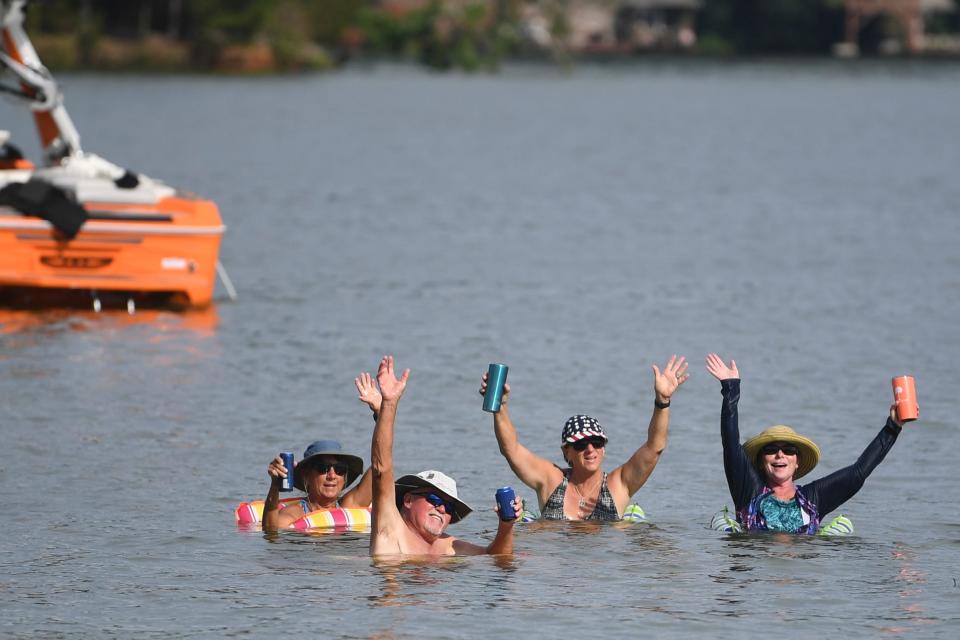The Tennessee River begins in Knoxville and flows right through the city, providing fun boating, kayaking and fishing opportunities. But where are the designated swimming areas along the river? Is it even safe to swim?
Fort Loudoun Lake, which is the part of the Tennessee River that runs through Knoxville, seems like it would be an ideal spot to take a dip in the waters and cool off on a hot summer day. That’s a little hard to do, though, if specified swimming areas that are free of passing boats and barges don’t exist.
Ahhh, but they do exist! Just not in Knoxville.
Are there designated swimming areas along the Tennessee River?
TVA manages all 652 miles of the Tennessee River system from Knoxville to Paducah, Kentucky. This includes managing flood control, navigation, hydroelectric generation, recreation, water quality and supply, and nine dams and reservoirs on the river.
Among the recreation activities, there are 15 public beaches where you can cool off with a swim or relax on the beach. The water is great for swimming from May to October, according to TVA. Unfortunately, none of these designated areas is in Knoxville.
Why aren’t there any TVA-managed swim areas in Knoxville?
Topography, water currents and flow, and boat and barge traffic are a few reasons why there aren’t any river swim areas managed by TVA in Knoxville, said TVA spokesperson Scott Brooks.
Brooks also noted there aren’t many places owned by TVA on the Tennessee River that are wide enough or shallow enough for a safe swim beach.
Even so, swimming and boating are acceptable forms of recreation on the entire 652-mile length of the Tennessee River – albeit at your own risk.
The Tennessee River and TVA reservoirs are public waterways accessible for public use unless otherwise posted, and are subject to all applicable state, federal and local laws, according to TVA.
Is it safe to swim anywhere in the Tennessee River?
But just because you can swim in the Tennessee River, should you?
All untreated recreational waters, such as springs, streams, ponds, lakes, rivers and oceans, naturally contain bacteria, viruses and parasites from the environment, according to the Tennessee Department of Environment and Conservation.
TDEC recommends people bathe after any contact with untreated recreational waters.
Whenever high bacteria levels in a body of water pose a potential risk to people, a bacteriological advisory is posted by TDEC. Advisories are shared through news releases, posted warning signs and an updated advisories list.
Bacteriological and fishing advisories can be found at tn.gov/environment.
There was no bacteriological advisory for Fort Loudoun Lake in Knoxville that would impact swimming in our area as of July 1.
The last time a bacteriological advisory was issued for the Fort Loudoun Lake in Knoxville, according to electronic TDEC records, the advisory was for the Sinking Creek Embayment in West Knoxville and was lifted in 2013.

You can swim in these nearby spots
The closest TVA-managed swimming areas within 100 miles of Knoxville include:
-
Douglas Headwater and Tailwater Dam Reservation near Dandridge, 28 miles from Knoxville
-
Tellico Dam Reservation in Lenoir City, 28 miles from Knoxville
-
Cherokee Dam Reservation near Jefferson City, 31 miles from Knoxville
-
Watts Bar Dam Reservation near Spring City, 61 miles from Knoxville
-
Parksville Beach near Ocoee, 99 miles from Knoxville
-
Boone Dam Reservation in Kingsport, 99 miles from Knoxville
In Knoxville, the Cove at Concord Park and other places along the river have small beaches to enjoy that aren’t operated by TVA.
TVA-managed swimming areas on the Tennessee River itself include:
-
Watts Bar Dam Reservation near Spring City, 61 miles from Knoxville
-
Chickamauga Dam Reservation near Chattanooga, 108 miles from Knoxville
-
Nickajack Shellmound Day Use Area near South Pittsburg, 133 miles from Knoxville
-
Point Mallard Park near Decatur, Alabama, 240 miles from Knoxville
-
Paris Landing State Park near Buchanan, 273 miles from Knoxville
TVA’s beaches are not staffed by lifeguards. More information and a full list of TVA’s swimming areas in the Tennessee River system are available at tva.com/environment/recreation/swim-beaches.
Where else can you swim in Knoxville?
If you don’t want to risk taking a dip in the river, Knoxville has many opportunities for summer swimming and other water activities.
Outdoor pools: Ed Cothren Pool (1737 Reynolds St.) and Inskip Pool (4204 Bruhin Road) are the two public outdoor pools managed by the city. Admission for the 2024 season is $3 per person at Ed Cothren and $4 at Inskip.
Admission to the public Oak Ridge Outdoor Swimming Pool (172 Providence Road, Oak Ridge) is $4.25 for adults during the 2024 season.
The City of Knoxville also recently started a summer program called Swim2Paddle for people, particularly minority adults and older adults. The program teaches people how to swim, then how to paddle in a clear-water pool and then how to paddle in the river.
Put-ins: Public put-ins are available at Holston River Park, Ijams Nature Center, Island Home Park, Suttree Landing Park, Governor Ned McWherter Park, James White Dock, Volunteer Landing, Sequoyah Hills and Lakeshore. Motorized options are available at Neyland Drive Boat Ramp.
Quarries: Mead’s Quarry at Ijams Nature Center has a designated swimming area and other activities such as paddling, canoeing and fishing. This is a swim at your own risk area because of sudden drops, possible rockslides and no lifeguards on duty.
Augusta Quarry at Fort Dickerson Park is closed for the 2024 summer season because of a renovation project, but it is a popular swimming hole. It is expected to reopen at the end of 2024.
Fishing: Fountain City Park Pond, Victor Ashe Park Pond, Holston River Park, and many areas along the river, including Island Home, Suttree Landing, Volunteer Landing and along Neyland Greenway are popular fishing spots.
The Tennessee Riverline’s interactive map at arcg.is/1eGHmW can be a helpful tool to find river features and nearby amenities.
Know Your Knox answers your burning questions about life in Knoxville. Want your question answered? Email [email protected].
Devarrick Turner is a trending news reporter. Email [email protected]. On X, formerly known as Twitter @dturner1208.
Support strong local journalism by subscribing at knoxnews.com/subscribe.
MORE QUESTIONS ANSWERED BY KNOW YOUR KNOX
When you’re apartment-hunting in Knoxville now, you’re bound to find listings that say (or at least seem to be priced as) “luxury apartments.” But what some landlords call luxury doesn’t always meet the textbook definition for what’s technically considered luxury or “class-A” apartments. Silas Sloan looks into Knoxville’s high-end rental market.
Even a cursory reading of the Tennessee Valley Authority Act, the 1933 federal legislation that created the nation’s largest public power provider, suggests its headquarters should be in Alabama and not Knoxville, Tennessee. So how did Knoxville win out over Muscle Shoals, Alabama? Not without a fight – and one that Knoxville nearly lost, Daniel Dassow relates.
One corner of the University of Tennessee campus in Knoxville has cameras pointed at it at all times, livestreaming anything that happens there 24/7. The UT Police Department patrols the area. A student group monitors the corner. All eyes focus on one thing: a giant rock. Keenan Thomas explains how this campus landmark relates to free speech.
This article originally appeared on Knoxville News Sentinel: Where can you swim in the Tennessee River in Knoxville?
Source Agencies



